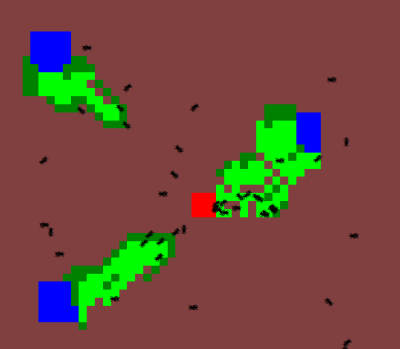Table of Contents
ANTS
- Compressed source code:ants_code.zip
- Seminar presentation : ants.pdf
- TerraME version: 1.3.0
AUTHORS: Fesseha Belay & Javier Morata
WHAT IS IT?
In this model, a colony of ants are forming or bring in to being their food from a certain place to the nest where they are living. Ant colonies are very interesting entities because of their capacities to collectively achieve complex decisions based on simple behavioural rules and the use of local information and indirect communication.This behaviour is useful to researches from different field, especially in Swarm Robotics and computational intelligence. Though,each ant follows a set of simple rules, the colony acts in a complex way. The purpose of this model is to simulate how ants are behaving while they are making their food.
HOW IT WORKS
The decision of the ants are controlled by the laying/following of trials of a chemical substance called Pheromone.When given the choice among several alternative paths, ants choose a path based on the Pheromone concentration over the possible path.This mechanism allows the selection of the shortest path among several ones. By the time an ant finds a piece of food, it carries the food back to the nest,dropping a chemical as it moves. When other ants “sniff” the chemical, they follow the chemical toward the food. As more ants carry food to the nest, they reinforce or increase the amount of chemical.
HOW TO USE IT
In order to show the ants symbol on the screen, firstly the animal font must be installed on your operating system. It is possible to find it inside the .zip file.
The user can change the following parameters to see the changes in the model. Changing the diffusion rate and the evaporation rate will affect to the behaviour of the ANTS.
Size of the society of agents: SOCIETY_SIZE
Size of cellularspace nxn: SPACE_DIMENSION
Simulationn temporal extent: FINAL_TIME
Controls the diffusion rate of the chemical: RATE_DIFFUSION
Controls the evaporation rate of the chemical: RATE_EVAPORATION
THINGS TO NOTICE
This section could give some ideas of things for the user to notice while running the model (e. g. model analysis, evaluation, charts, maps, screenshots, etc).
Some of the things that is noticed while running the model are:
1. The ants start to move randomly from the nest to search for the food irrespective of the whereabout of the food.They may find a food either in the very vicinity of the nest or far. It is observed that the food which is near to the nest usually finished up first.
2. From the graph which shows the food consumption by the ants,it is shown that when the ants find the food the gradient of the curve is steep. Whereas, by the time the ants find no food, the curve will have a horizontal line.
3. when there is big amount of food, the food is taken up with in a short period of time because the ants get the food easily and drop more chemical. On the other hand, with less amount of food, it took longer time for the food to be taken up. This may be due to the fact that there are less chemicals around the food.
THINGS TO TRY
This section could give some ideas of things for the user to try to do with the model. For example:
- Try to vary parameter SOCIETY_SIZE with different values.
- Try to vary RATE_DIFFUSION to 2, 3, 4, etc and see what will happen.
- Try to vary RATE_EVAPORATION to 0.25, 0.5, 0.75 and see what will happen.
- Try to Change the neighbourhood method to vonNeuman and see what will happen.
EXTENDING THE MODEL
The model can be extended in the following ways
1.It would be nice to see the behaviour of the ants(how ants behave) by varying the food location in such a way that the foods are located at equal distance from the nest.
2. In this model, the ants use a “TRICK” to find their way to their nest. In reality, ants use a varaity of different approaches to find their way back to the nest. It would be good to implement other starategies and see how the behaviour changes.
3. In the mechanism for sniffing of the chemicals, the ants sniff in three directions and then turns to the direction where the chemical is stronger.The model can be extended by considering more directions than the three.
TerraME FEATURES
The main features being used from TerraME are as follows:
- Agent
- CellularSpace
- Environment
- Event
- Legend
- Observer
- Society
- Timer
RELATED MODELS
CREDITS AND REFERENCES
This model is inspired from: NetLogo Ants Model
Second model used from: Repast Simphony agent simulation toolkit
M. Dorigo et al. (Eds.): ANTS 2004, LNCS 3172, pp. 190-201, 2004 © Springer-Verlag Berlin Heidelberg 2004


